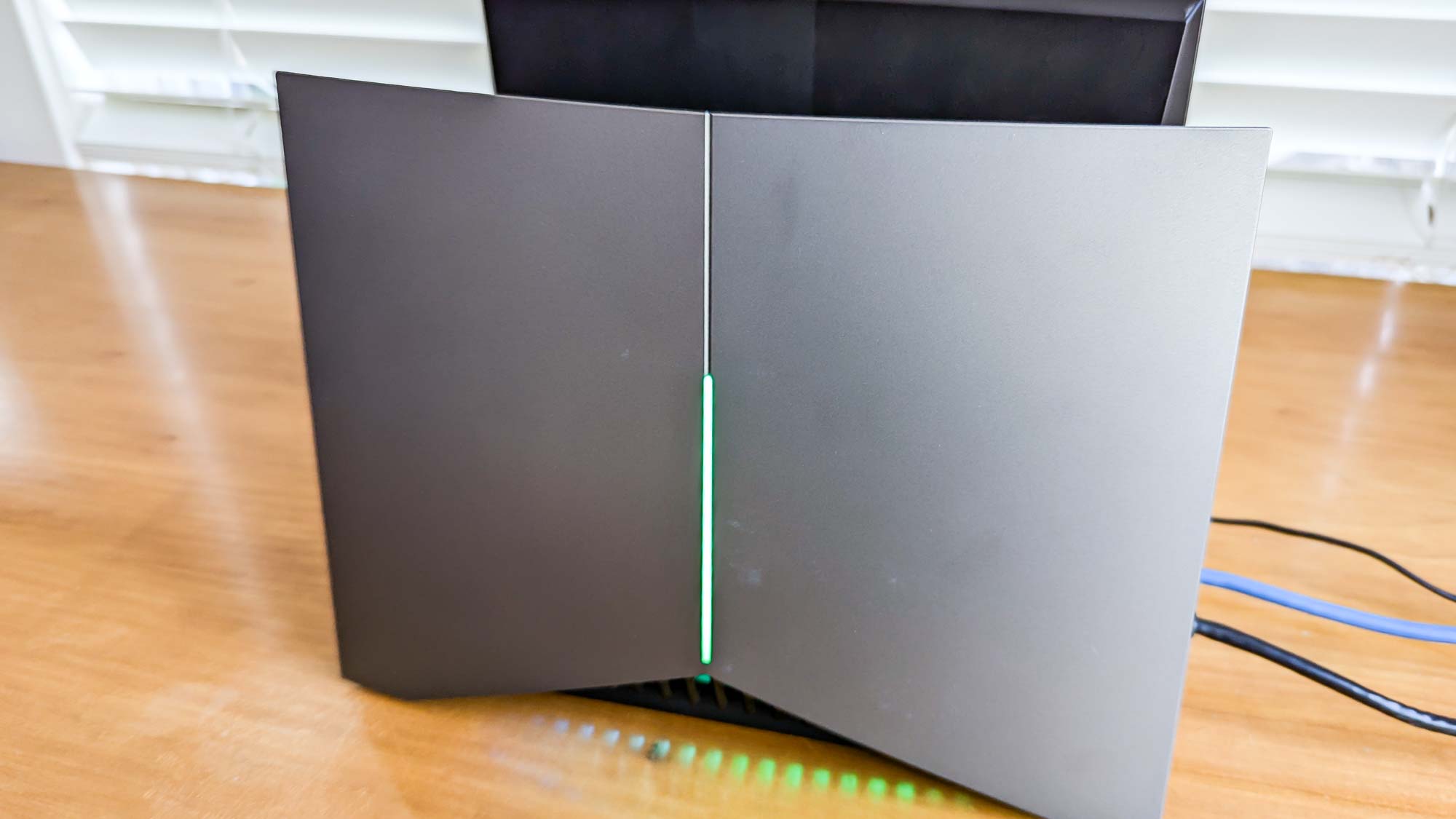
Wi-Fi Spec: BE19000/tri-band 802.11be
Number of Antennas/Removable: 8/No
Ports: 2 10Gbps WAN/4 2.5Gbps LAN/SFP+ optical connection. USB 3.0
Processor/Memory/Flash Storage: 2.2GHz quad core/2GB/256MB
Wi-Fi chip: Qualcomm Networking Pro 1220
Peak 802.11ac performance: 1.322Gbps (at 15 feet)
Range: 105 feet
Size: 11.5 x 9.0 x 7.4 inches
By combining some of the fastest online connections available with all Wi-Fi 7 has to offer, TP-Link’s Archer GE800 gaming router goes all out trying to give gamers that little edge they crave. The tri-band GE800 starts with the Wi-Fi 7 basics, like 320MHz data channels and 4K QAM modulation, for the ability to move gigabits of data with ease but takes the technology to new levels with enticing extras, like the combination of two 10Gbps wired WAN inputs, an optical connection and four 2.5Gbps downstream wired networking ports. Plus, for those who like to show off, the GE800’s LED lighting effects are nothing short of mesmerizing.
Its bat wing design makes the GE800 big and all that heavy-duty hardware requires a cooling fan that’s only partially successful, yielding one of the hottest routers around – literally. Unfortunately, the router leaves some performance on the table, making the Archer GE800 better at mid-distances than up close. The question is whether rabid gamers seeking galactic supremacy will pony up $599 for a router that doesn’t have bragging rights as the fastest around.
TP-Link Archer GE800 review: Pricing and availability
With an intro price of $499, the TP-Link Archer GE800 brings Wi-Fi 7 to online gamers but is one of the most expensive traditional routers on the market. It’s aimed at gamers and those who crave an extra online advantage but costs twice that of competitive gear, like the Wi-Fi 6-based Netgear Nighthawk XR1000.
TP-Link Archer GE800 review: Design
No shrinking violet, the Archer GE800’s gray and black batwing design is among the largest home routers ever sold. At 11.5 x 9.0 x 7.4, it’s easily twice the size of other high-performance routers and is reminiscent of the Netgear Nighthawk RAXE500. That said, the center is mostly empty space and provides a convenient place to stash the mail or a couple of remote controls.

The wings are more than ornamental, though, with eight antennas. In between, on the router’s front, the GE800 has buttons for using the Wi-Fi Protected Setup (WPS) for quickly adding clients, to turn the Wi-Fi on or off and to kill the LED lighting. The most interesting thing for gamers is the rocket ship acceleration button to start up the router’s Game Mode.

Along the way, the GE800 can startle with wing-mounted LED strips that light up a vertical line reaching to the cooling vents below. The light show can be programmed with 13 different creative effects, although several end up looking like Darth Vader swallowed a flashlight. The router interrupts the show to display warnings, like a blinking red light when the device is offline.

Inside, the Archer GE800 uses Qualcomm’s mid-range Networking Pro 1220 chipset to create 12 streams of 4X4 traffic. This puts it a step down from the more capable Networking Pro 1620 circuit that can handle 16 independent streams of data. It’s all controlled by the router’s 2.2GHz quad-core processor, 2GB of RAM and 256MB of storage space for its firmware and settings.
It’s top shelf with Wi-Fi 7’s 4K QAM modulation, high-speed 320MHz data channels and Multi-Link Operations to bond its bands together. On the downside, all this high-powered hardware heats up quickly and requires a fan to pull air in from the sides and bottom. The hot air exhausts up from between the wings. Happily, the fan only runs when it’s needed and isn’t loud enough to interfere with blaster noises but as you’ll see it wasn’t 100% totally effective.
An up-to-date router, the GE800 has been designed to move up to 1.376 Gbps over the 2.4GHz band as well as 5.764 Gbps and 11.528 Gbps over the 5GHz and 6GHz bands. It garnered a BE19000 rating, making it among the fastest routers available.

Its low latency design is aimed squarely at committed gamers looking for a millisecond lead over opponents. In fact, the Archer GE800 just might be the best connected home router available with a port panel that mirrors that of the Archer BE800 with two 10 Gbps wired WAN connections and an SFP+ optical link. Any two of its four 2.5 Gbps downstream Ethernet connections can be aggregated for the truly data hungry. All this makes the GE800 years ahead of the broadband connections most of us have today but it’s good to know it’s there.
The Archer GE800 has the luxury of a USB 3.0 port for making a data drive’s contents available throughout the network. This is something many other high-end routers lack.

Finally, the Archer GE800 is security-minded with HomeShield Standard included. A cloud-based way to protect a home network and its clients from intruders and malware, there are network scans for dangers as well as security for smart home cameras. That said, the Security + At-Home plan costs $36 and adds things like Web protection and Intrusion prevention. The On-the-Go plan costs $70 and also has Norton 360 client anti-malware software that puts it on the same level as Netgear Armor with Bitdefender software, although the TP-Link plan costs less.
TP-Link Archer GE800 review: Performance
Based on the full Wi-Fi 7 protocol, the TP-Link Archer GE800 has a theoretical peak output of 18.668 Gbps. As is always the case, it didn’t come close to this throughput in real world testing. It did manage to cover every corner of my 3,500 square foot home, including places many others missed.
Using Keysight’s IxChariot networking benchmark set to simulate 10 active users with the router next to an Acer Swift Edge 16 test system, the GE800 hit a peak throughput of 1.696 Gbps. That’s more than enough for even obsessive gamers but is a third less than the 2.685 Gbps that the Asus RT-BE96U was able to deliver.
When I switched to a 2.5Gbps wired connection, the test system’s throughput rose to 4.449Gbps using 6-feet of Cat-6 cabling. This makes it perfect for your next LAN party and just ahead of the Orbi 773’s 4.280Gbps under the same conditions.
Of course, few people use their computers next to the router, and at a more realistic 15-feet, the wireless throughput for the Archer GE800 fell off by nearly 22% to yield 1.322 Gbps. Still behind the RT-BE96U’s 1.94 8Gbps, it’s a lot of bandwidth for everything from 4K movies to battling an opponent on the other side of the Pacific Ocean.
With the GE800 and test system 50 feet apart, the Archer GE800 led the pack with 456.7 Mbps of throughput. That’s enough to give it bragging rights at mid-range distances against the likes of the RT-BE96U (at 392.7 Mbps), the ROG Rapture GT-AXE11000 (267.9 Mbps) and Netgear Nighthawk XR1000 (233.4 Mbps).
At 75 feet, the router’s throughput fell to 197.1 Mbps, half the 402.1 Mbps that the RT-BE96U delivered and 100 Mbps less than the Nighthawk XR1000 offered. It did manage to blow away the ROG Rapture GT-AXE11000’s 98.3 Mbps.
Our terminal distance of 90 feet showed the Archer GE800 to be going strong with 65.8 Mbps of bandwidth on tap. That’s better than the ROG Rapture GT-AXE11000, which was out of range and twice that for the RT-BE96U’s 31.4 Mbps, but second best compared to the Nighthawk XR1000’s 74.9 Mbps. The Archer GE800 had a range of 105 feet, making it a long-distance champ.
It was able to send its Wi-Fi signal across a 25-foot room and through a wall providing 931.7 Mbps to the test computer. That’s half as good as the RT-BE96U’s 1.810 Gbps, however.
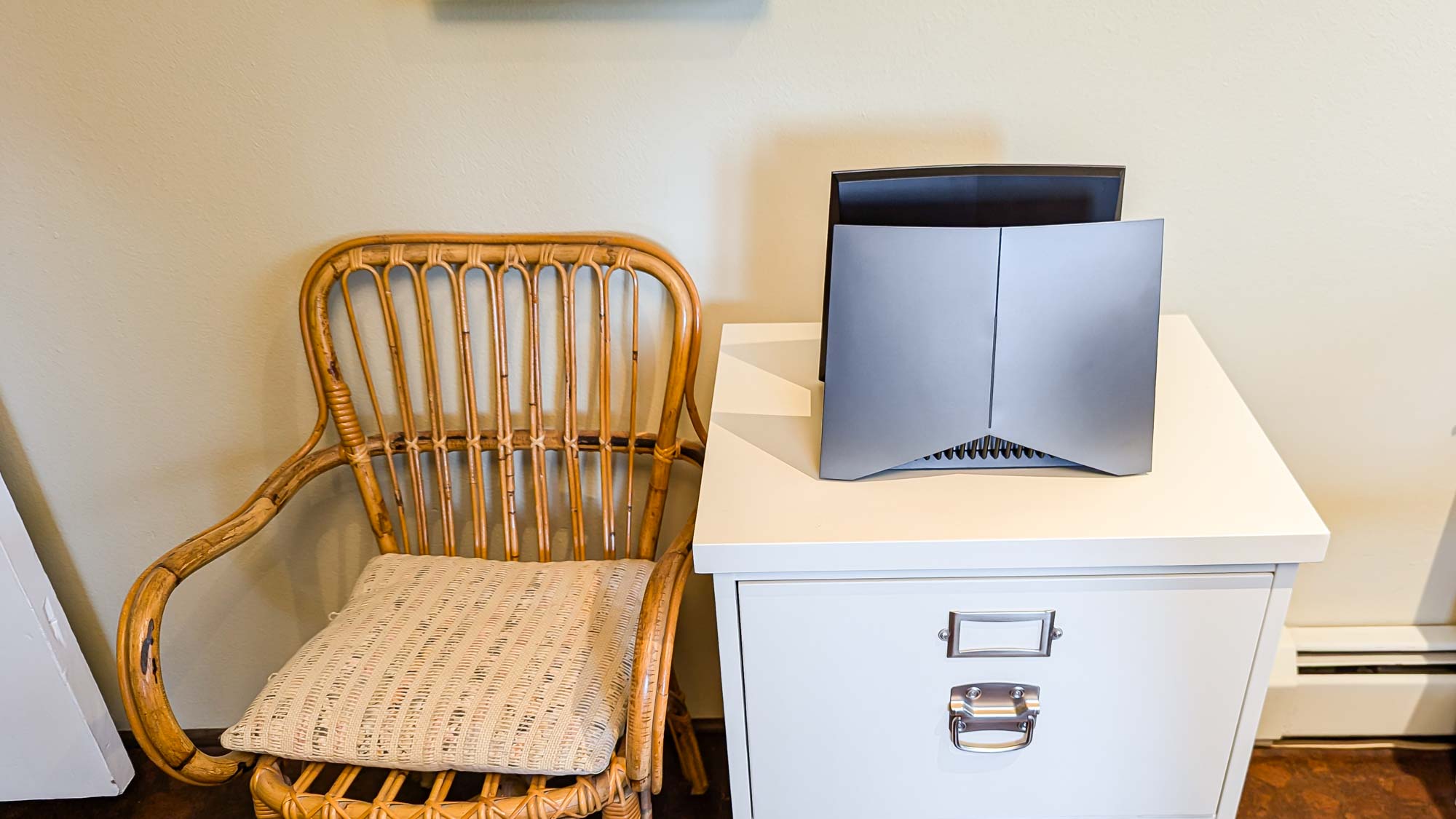
Over the course of three weeks of daily use for everything from some digital dirt driving to watching online videos, the Archer GE800 proved to be a reliable router. It not only filled my house with data but was dependable with rock solid throughput and easily passed my informal saturation test. While a Mac Mini was streaming a baseball game and a ThinkPad 470 moved data to and from a RAID storage system, a Samsung Galaxy Book played YouTube videos and an iPad Pro tapped into the BBC World Service audio feed. It played everything faithfully with neither skips nor dropouts.
Even with its fan blowing, the Archer GE800’s underneath was hot to the touch at a peak 138.0 degrees Fahrenheit. The exhaust space between its antenna wings was a more reasonable but still hot 120.1 degrees Fahrenheit. This makes the GE800 one of the hottest routers I’ve ever seen or touched.
As you might expect, the Archer GE800 is power hungry, topping out at 26.7 watts when the LEDs are on and 19.2 watts when they’re off. If you pay 16 cents per kilowatt hour of electricity, the national average, expect the GE800 to cost $37.50 to operate if the LEDs are left on; that drops to $27 if they’re always off.

The middle ground is TP-Link’s Night Mode that schedules the lighting effects and can reduce the router’s annual power bill to $34.
TP-Link Archer GE800 review: Setup
The TP-Link GE800 can be set up either with a connected browser or the company’s Tether app for Android or iOS. I used the former with my Acer Swift Edge 16 system to install it in about four minutes.
After I plugged everything in and connected it to its default address – the passcode is underneath – I typed “tplinkwifi.net” into the address bar. It connected right away and asked for a new administration password and time zone.

Finally, I needed to enter that I was going to use the 10 Gbps WAN port. Later, I changed the default network name and passcodes to something more personal.

It fired up immediately with a full-speed Internet connection.
TP-Link Archer GE800 review: Gaming
A high-performance router designed by and for gamers, the GE800 has a convenient button with a rocket ship logo that puts the device into gaming mode.
Using a connected browser yields the most choices but the app is easier to make quick changes. The interface’s main screen opens in the Game Center that shows LAN traffic, CPU and memory usage for the router as well as any connected USB device.

Meanwhile, the RGB Effects area let me choose from the router’s 13 lighting effects. My favorite is spectrum, which runs through the primary colors, but it’s easy to turn off.

Below are places to increase your online mojo by using port forwarding, Server Acceleration and Quality of Service (QOS) and Gear Acceleration. You’ll need a WTFast account to get the most out of it.
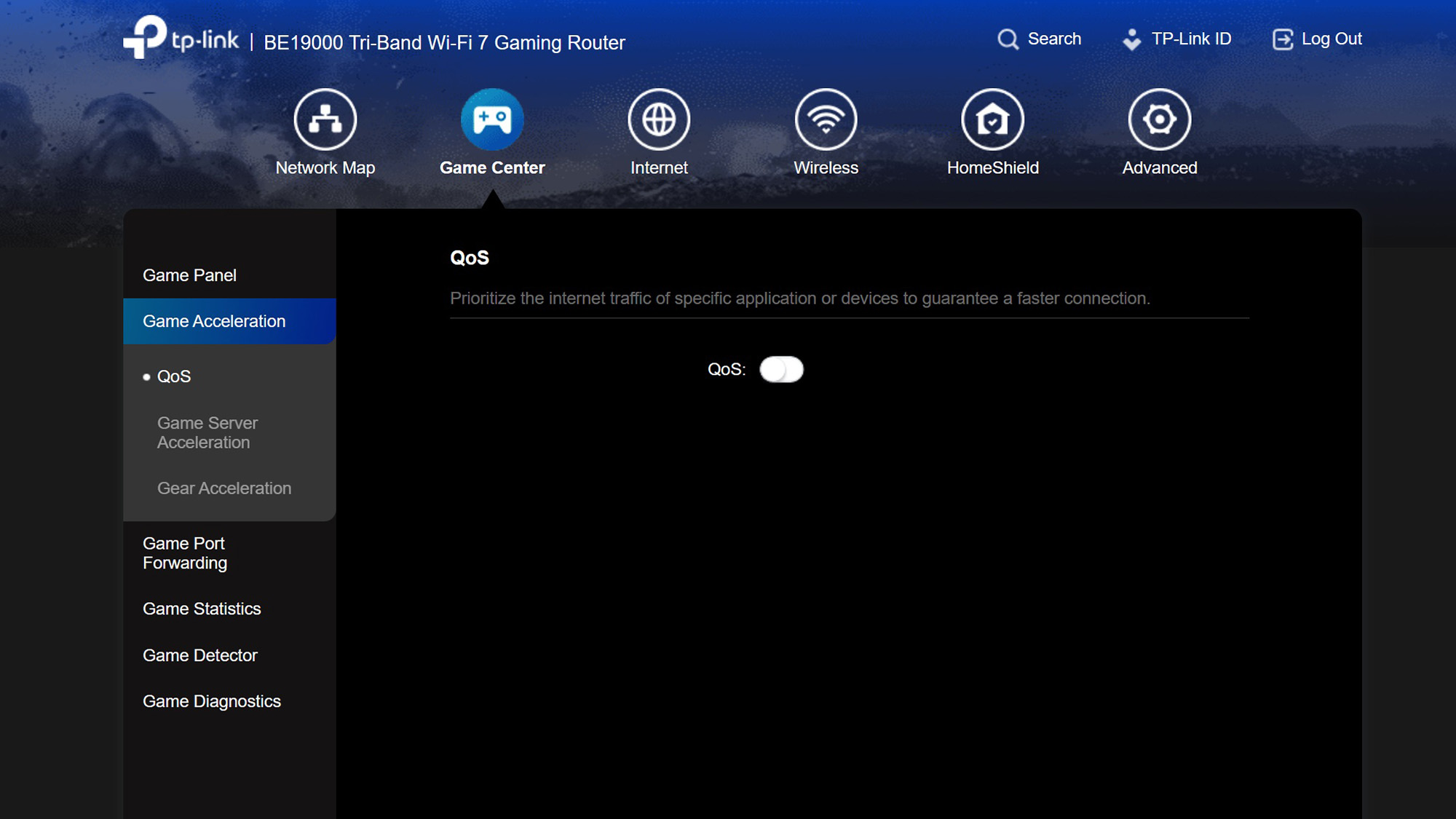
Along the left, Game Diagnostics might straighten out a networking problem with a Ping test. It lacks a world map of known fast (to use) and slow (to avoid) connections, however.

The Archer GE800 takes this a step further with the Game Detector. Able to check my Ping within any of 10 games without affecting any of the other settings, it’s a good first stop before starting a session.

TP-Link Archer GE800 review: Configuration
There’re lots of under the hood tricks up the GE800’s digital sleeve. They can be done with the Tether app or its interface with a connected browser. The latter is deeper with more options.

Its network map shows how many clients are connected, which bands are online and the IP address. There’s processor and memory usage levels.

The router also has a tab for the Internet with connection particulars as well as Wireless for combining bands into a single Smart Connect name, selecting the channel width and changing the LAN’s connection details.

Anyone who likes tweaking configurations will love the Advanced section with scheduling Wi-Fi use and configuring the WPS quick connection method. It has key items that others leave out, such as Airtime Fairness, Beacon Interval and RTS Threshold settings.
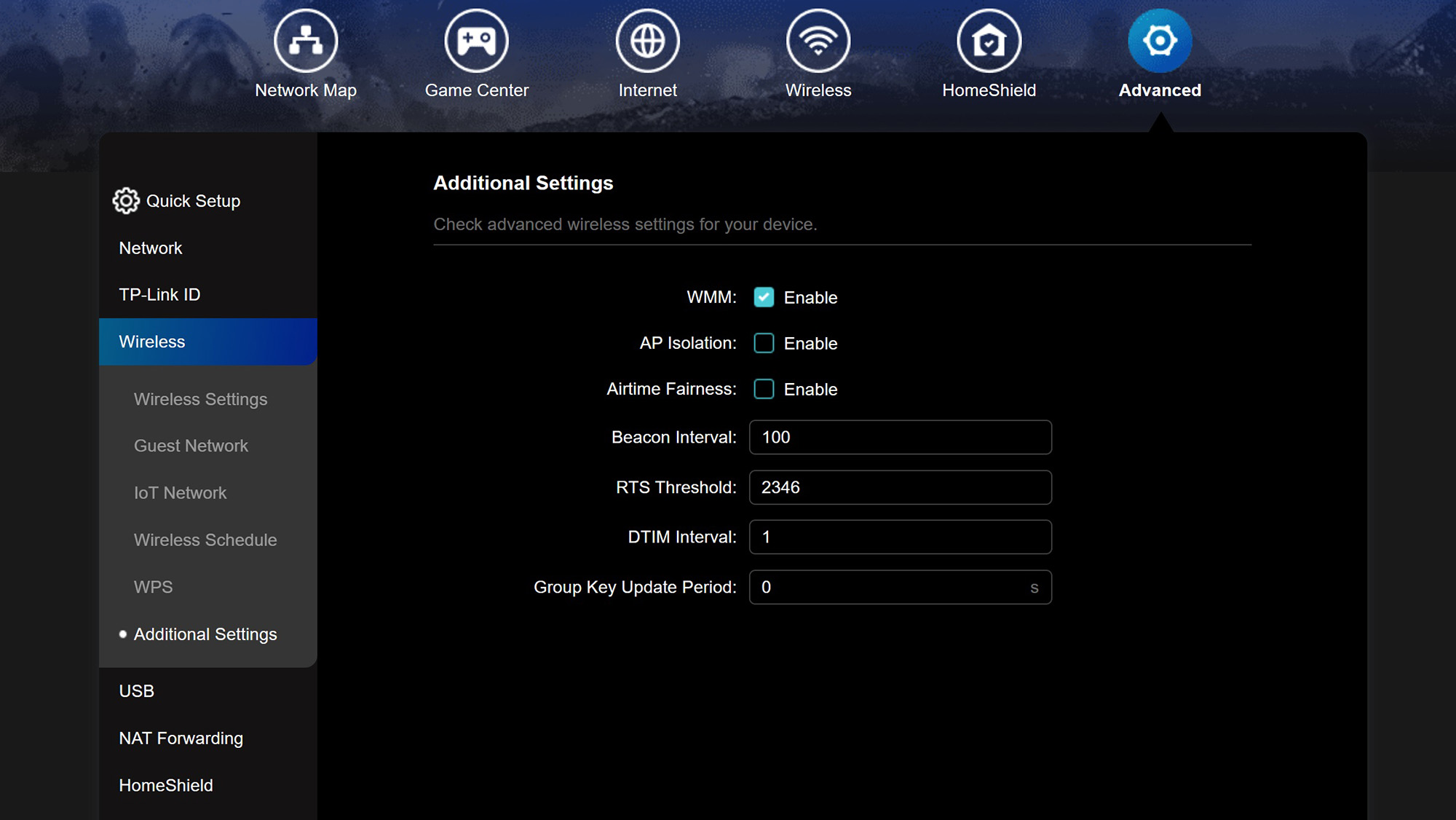
There are also thoughtful places to take control of IoT smart home devices, incorporate the GE800 as part of a mesh network and use it as a VPN server or client. My favorite is the traffic monitor’s visual approach to data flow.

Using an iPad Pro, the app approach is more finger friendly but only works vertically. The main page shows a pulsing router with “Working Well” when it’s online. It’s in Gaming mode with the current up- and download rates, number of clients and online status

Underneath are sections for the router’s main events, like data traffic and app usage, the Guest Network and Gaming details. I used it to adjust the RGB lighting effects.

There are sections for Family (for parental controls) and Security (for HomeShield choices). The More category seems like an after-thought but hides under the hood customization, like the ability to redo the setup, see the Wi-Fi and Internet details.
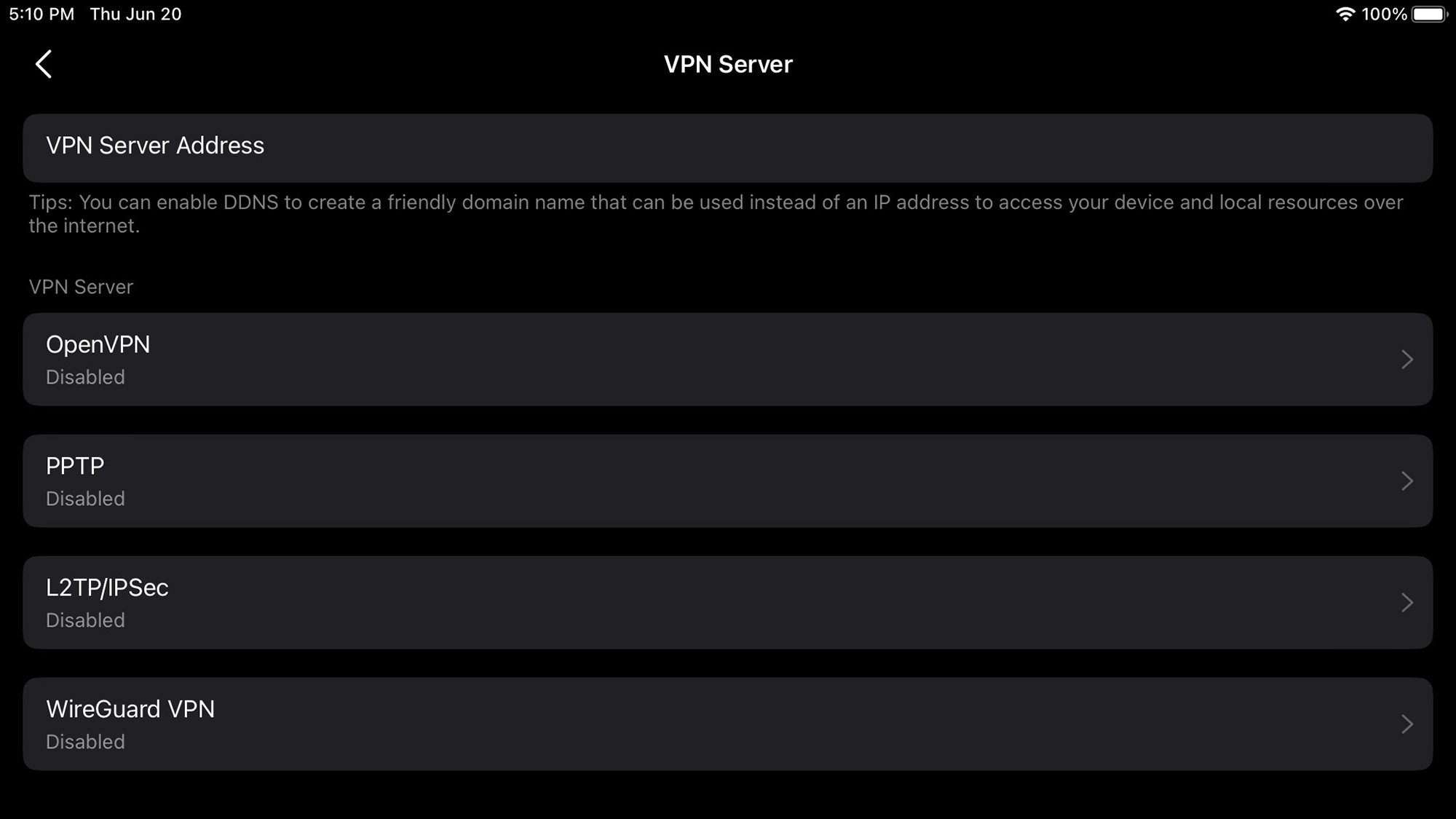
The Advanced settings has things like using the router as a VPN server but lacks the detail of the connected browser interface.
TP-Link Archer GE800 review: Verdict
In an online gaming world where every millisecond counts, TP-Link’s Archer GE800 may be the easiest way to scratch your opponent with an unrivaled Multi-Gig architecture that includes a set of 10 Gbps WAN connections, an SFP+ optical input and four 2.5 Gbps Ethernet ports. A USB connection for accessing a hard drive’s data across the network rounds out the ports. It’s got security covered and the GE800’s LED lighting effects make it a pleasure to use or just stare at between Fortnite battles.
Sure, it’s big, requires a fan and runs hot but falls short of delivering stratospheric throughput. To judge the GE800 based on raw speed alone misses the point because its connection choices, low latency design and gaming goodies make it a winner for fanatical gamers.
It’s moderately expensive at $599 but well worth it when you’re up against the best.







